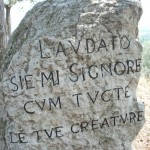What time is it? For Catholics, it’s always eternity.
My Patheos Catholic Channel colleague Mark Shea asked for prayers yesterday because he’d been invited to participate in a HuffPost discussion about “whether it’s time to end the celibate priesthood.” Leaving aside the chances (nil) that what the Huffington Post wants to do with this topic is anything resembling discussion, the question itself gives me fidgets. It’s emblematic of the cluelessness of so much of the interregnum blather, from without the Church and (sadly) from within.
This business of whether it’s time for the Church to do something or other—ordain women, end the Western discipline of clerical celibacy, recognize gay marriage, or even turn the altars back around and return to the Latin Mass—operates from a false assumption. For it to be “time” for the Church to take some action or make some change presumes that the Church operates on the world’s timetable, bound to regular updating (or, in the trads’ view, backdating) or doomed to obsolescence.
But the Church is not a computer operating system, or a college textbook, or a clothing line. It does not require regular upgrades in order to satisfy the demands of the marketplace. In fact, such slavish attention to the moment would doom the Church to obsolescence.
The moment—whatever the moment is—is ephemeral. The Church’s clock is set to eternity.
That means we are always living fully in three dimensions. Our now encompasses the past that shaped us and the future that beckons us. We stand, in a world of ticking timers and fickle fashions, for timelessness.
This does not mean the Church is ignorant of time, or immune to its effects. In fact, the world’s calendar is a product of the Church, of its great gift of marking the passage of the seasons, the numbering of days, the celebration of the moments that recur in our lives. Our “red-letter days” are a memory of the Church’s marking of religious feasts in red. Yes, we received this heritage of sanctifying the calendar from our Jewish ancestors, and we freely incorporated the customs with which many natural religions celebrated the seasons and sacramentalized the gifts of creation. But our purpose was never “to keep up with the times.” It was our way of infiltrating eternity into time, not the other way around.
And yes, the Church and its leadership have often been guilty of mistaking the world’s calendar for the clock of eternity. At our worst, we have reflected the times too well instead of challenging them. We have listened to the voice of the world crying “It’s time!” rather than the voice of the Spirit crying “Eternity!”
An interregnum is a particularly dangerous time for this. The voice of the world’s clock is so seductive. That’s why it’s so important to call on the Holy Spirit now. The cardinals, on Monday, will begin to synchronize their watches to eternity. When the Conclave begins, they will gather under Michelangelo’s great reminders of the Alpha and the Omega—the creation of the world and its final judgment. If they are faithful, the pope they choose and the Church he will lead in these times will do many things and take many actions. Some of these things—who knows?—may appear surprising and radical and new. But it will not be because “it’s time.”
It will be because we are once again calling the world to the timeless reality of the Gospel. Come, Holy Spirit! To infinity and beyond!











